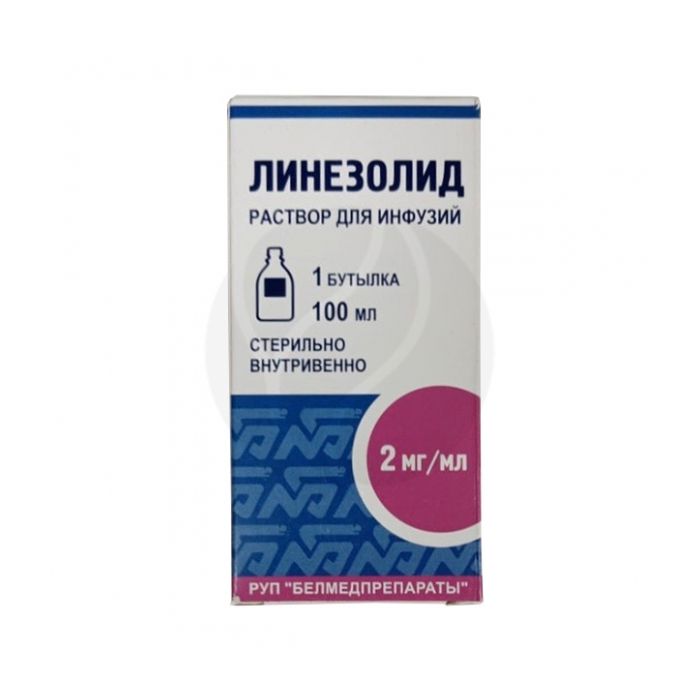Linezolid solution for infusion 2mg / ml, 100ml
Expiration Date: 05/2027
Russian Pharmacy name:
Линезолид раствор для инфузий 2мг/мл, 100мл
Treatment of infectious and inflammatory diseases, if known or suspected that they are caused by aerobic and anaerobic gram-positive microorganisms sensitive to linezolid (including infections accompanied by bacteremia):
community-acquired pneumonia caused by Streptococcus pneumoniae (including multiresistive strains), including cases accompanied by bacteremia, or Staphylococcus aureus (methicillin-susceptible strains only);
hospital pneumonia caused by Staphylococcus aureus (including methicillin-susceptible and methicillin-resistant strains) or Streptococcus pneumoniae (including multi-resistant strains);
complicated infections of the skin and soft tissues, including infections with diabetic foot syndrome, not accompanied by osteomyelitis, caused by Staphylococcus aureus (including methicillin-susceptible and methicillin-resistant strains), Streptococcus pyogenes or Streptococcus agalactiae; infections resistant to vancomycin caused by Enterococcus faecium, including those accompanied by bacteremia.
If pathogens include gram-negative organisms, combination therapy is clinically indicated.
The drug is intended for intravenous administration. The duration of the infusion is 30-120 minutes. The dosage regimen and duration of treatment depend on the pathogen, location and severity of the infection, as well as on clinical efficacy.
The solution for infusion is clear, colorless or slightly yellowish.
1 ml linezolid (form III) 2 mg
Excipients: dextrose (anhydrous glucose), sodium citrate, anhydrous citric acid, water d / i.
Hypersensitivity to linezolid and / or other components of the drug;
pharmachologic effect
Antimicrobial agent, belongs to the class of oxazolidinones. The mechanism of action is due to the selective inhibition of protein synthesis in bacteria. By binding to bacterial ribosomes, linezolid prevents the formation of a functional 70S initiation complex, which is a component of the translation process in protein synthesis.
It is active against aerobic gram-positive bacteria: Corynebacterium jeikeium, Enterococcus faecalis (including glycopeptide-resistant strains), Enterococcus faecium (including glycopeptide-resistant strains), Enterococcus casseliflavus, Enterococcus gallinapillinarum strains, Enterococcus gallinapocyllus strain aureus (strains with intermediate susceptibility to glycopeptides), Staphylococcus epidermidis (including methicillin-resistant strains), Staphylococcus haemolyticus, Staphylococcus lugdunensis, Streptococcus agalactiae, Streptococcus pneumoniae, Streptococcus pneumoniae, Streptococcus pneumoniae susceptible spp. (streptococci of groups C and G), Streptococcus pyogenes, Streptococcus viridans;aerobic gram-negative bacteria: Pasteurella canis, Pasteurella multocida; anaerobic gram-positive bacteria: Clostridium perfringens, Peptostreptococcus spp. (including Peptostreptococcus anaerobius); anaerobic gram-negative bacteria: Bacteroides fragilis, Prevotella spp .; Chlamydia pneumoniae.
Less active against Legionella spp., Moraxella catarrhalis, Mycoplasma spp.
Not active against Haemophilus influenzae, Neisseria spp., Enterobacteriaceae, Pseudomonas spp.
There was no cross-resistance between linezolid and aminoglycosides, beta-lactam antibiotics, folic acid antagonists, glycopeptides, lincosamides, quinolones, rifamycins, streptogramins, tetracyclines, chloramphenicol because the mechanism of action of linezolid differs from the mechanisms of action of these antibacterial drugs.
Resistance to linezolid develops slowly by multistep mutation of 23S ribosomal RNA and occurs with a frequency of less than 1 ? 10-9-1 ? 10-11.
Pharmacokinetics
Linezolid is rapidly distributed in tissues with good perfusion. Vd upon reaching Css in healthy volunteers averages 40-50 liters. Plasma protein binding is 31% and does not depend on the concentration of linezolid in the blood.
It was found that cytochrome P450 isozymes are not involved in the metabolism of linezolid in vitro. Linezolid also does not inhibit the activity of clinically important cytochrome P450 isoenzymes (1A2, 2C9, 2C19, 2D6, 2E1, 3A4). Metabolic oxidation leads to the formation of 2 inactive metabolites - hydroxyethylglycine (which is the main metabolite in humans and is formed as a result of a non-enzymatic process) and aminoethoxyacetic acid (formed in smaller quantities). Other inactive metabolites have also been described.
Linezolid is excreted mainly in the urine in the form of hydroxyethylglycine (40%), aminoethoxyacetic acid (10%) and unchanged drug (30-35%). It is excreted with feces in the form of hydroxyethylglycine (6%) and aminoethoxyacetic acid (3%). The unchanged drug is practically not excreted in the feces.
Side effect
From the digestive system: often (> 1%) - taste perversion, nausea, vomiting, diarrhea, abdominal pain (including spastic pain), flatulence, changes in total bilirubin, ALT, AST, ALP.
From the hematopoietic system: often (> 1%) - reversible anemia, thrombocytopenia, leukopenia, pancytopenia.
Others: often (> 1%) - headache, candidiasis; rarely - cases of peripheral neuropathy and neuropathy of the optic nerve when used for more than 28 days (the relationship between the use of linezolid and the development of neuropathy has not been proven).
Adverse reactions are independent of dose and usually do not require discontinuation of treatment.
Application during pregnancy and lactation
There have been no adequate and well-controlled studies of the safety of linezolid during pregnancy. The use of linezolid during pregnancy is possible only if the intended benefit of therapy to the mother outweighs the potential risk to the fetus.
It is not known whether linezolid is excreted in breast milk, therefore, if it is necessary to use the drug during lactation, breastfeeding should be discontinued.
special instructions
With the development of diarrhea while using linezolid, the risk of developing pseudomembranous colitis of varying severity should be taken into account.
In the course of treatment, it is necessary to carry out a clinical blood test in patients with an increased risk of bleeding, a history of myelosuppression, as well as with the simultaneous use of drugs that reduce the level of hemoglobin, the number of platelets or their functional properties, as well as in patients receiving linezolid for more than 2 weeks.
Drug interactions
Linezolid is a weak reversible non-selective MAO inhibitor, therefore, in some cases, linezolid is capable of causing a moderate reversible increase in the pressor action of pseudoephedrine and phenylpropanolamine. Taking this into account, with simultaneous use, it is recommended to reduce the initial dose of adrenergic drugs (including dopamine and its agonists) and subsequently select the dose by titration.

